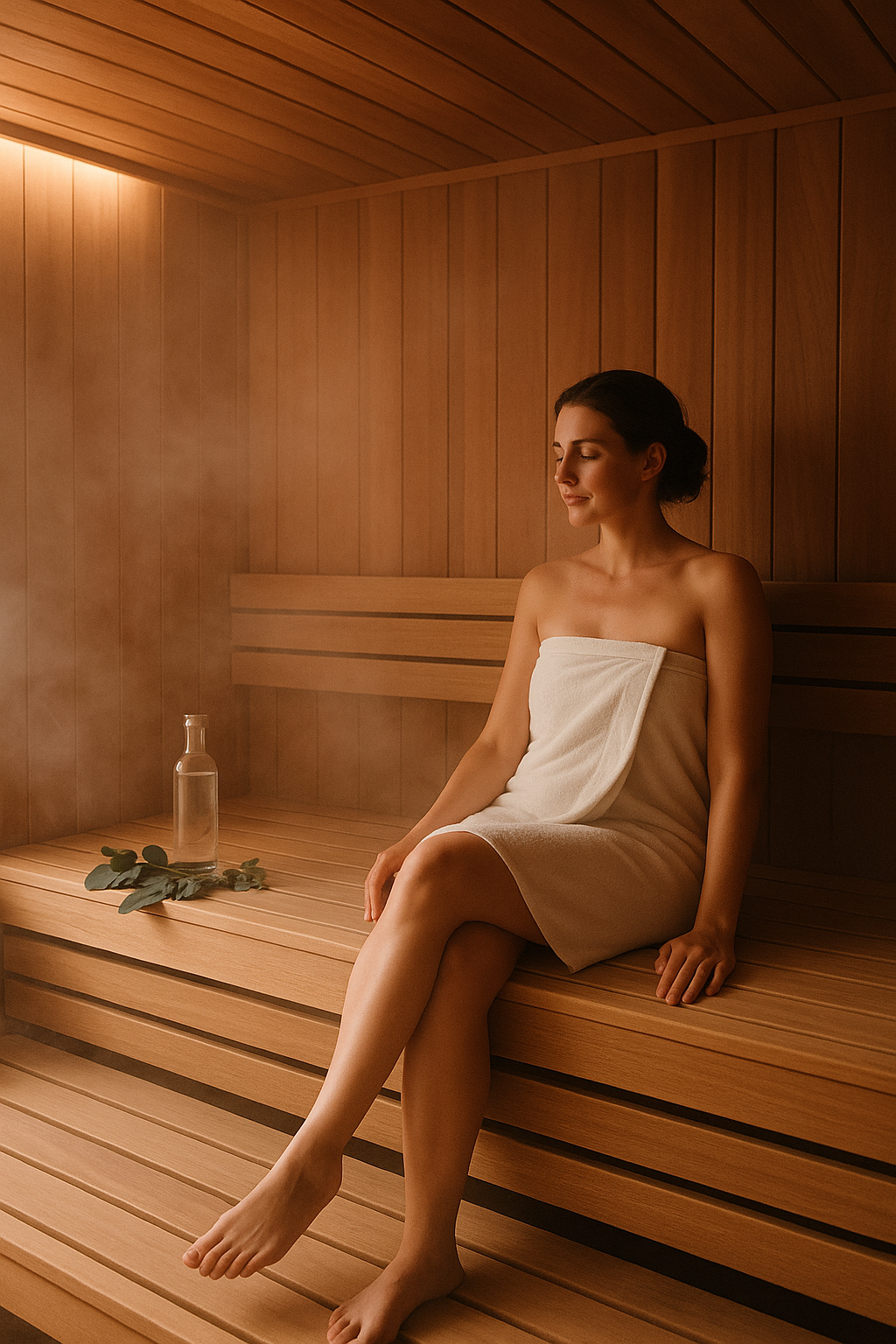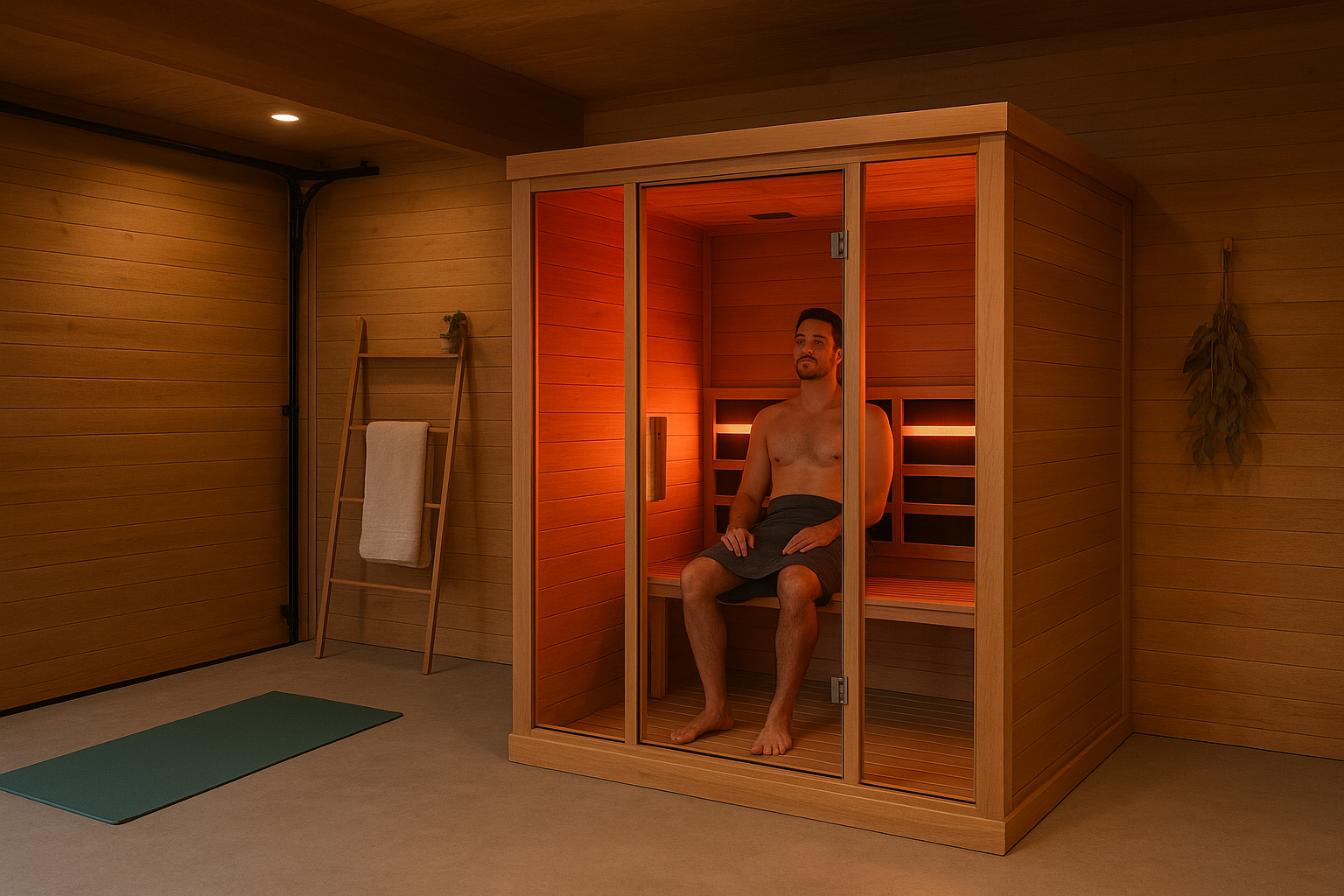Wet Sauna Guide: Boost Circulation, Detox Naturally, and Relax Deeply
The Powerful Revival of the Wet Sauna
The ancient tradition of steam bathing has been practiced across cultures for centuries. From Roman thermae to modern health spas, the wet sauna, also known as a steam sauna, has stood the test of time for one simple reason: it works. Whether you want to detox naturally, soothe sore muscles, improve circulation, or simply relax, a wet sauna can offer powerful physical and mental health benefits.
In this article, you'll discover exactly what a wet sauna is, how it compares to other sauna types like dry and infrared saunas, the science-backed health benefits, and practical tips for choosing the right one for your home.
What Is a Wet Sauna?
A wet sauna, often referred to as a steam sauna or steam room, is a deeply immersive heat therapy experience that envelops your body in warm, moist air. Unlike dry saunas, which use high temperatures with low humidity, wet saunas operate at milder heat—typically between 110°F and 120°F (43°C to 49°C)—but with nearly 100% humidity. This creates a gentler, steam-filled environment that encourages deep relaxation, detoxification, and respiratory relief.
How It Works:
- A heat source, typically electric or wood-fired, heats sauna stones.
- Water is poured over the stones to generate bursts of steam.
- The room fills with warm, heavy air that opens your pores and activates sweating.
- Your heart rate increases slightly, and blood flow improves as your body regulates temperature.
This experience mimics the warmth and humidity of natural hot springs or mineral spas, providing therapeutic benefits without the intense dry heat that some users may find uncomfortable.
Construction and Design Features:
Wet saunas are often built using aromatic and mold-resistant woods like cedar, hemlock, or spruce. Common interior features include:
- Tiered benches to allow users to control their exposure to heat
- Hygrometers and thermometers to monitor conditions
- Built-in steam heaters and optional timers or lighting controls
They can be installed as standalone outdoor units or incorporated indoors near bathrooms or home spa setups. Outdoor wet saunas are popular in colder climates where the contrast between chilly air and warm steam creates an invigorating experience.
Whether you're unwinding after a long day or boosting your wellness routine, the wet sauna’s combination of humidity, warmth, and natural materials delivers a deeply calming and revitalizing ritual.
Wet Sauna vs Dry Sauna: What’s the Difference?
While both types of saunas offer therapeutic benefits, the way they deliver heat and humidity makes the experience—and the benefits—quite distinct.
| Feature | Wet Sauna (Steam Sauna) | Dry Sauna (Traditional Finnish Sauna) |
|---|---|---|
| Temperature | 110°F - 120°F | 150°F - 190°F |
| Humidity | Nearly 100% | 5% - 30% |
| Heating Mechanism | Water poured on hot rocks | Electric or wood stove |
| Air Feel | Moist and heavy | Dry and intense |
| Health Focus | Detox, skin, breathing | Circulation, relaxation, inflammation |
Why Choose Moist Heat?
Moist heat penetrates more quickly into the skin and respiratory tract. For those with respiratory conditions, sinus issues, or dry skin concerns, the environment of a wet sauna is gentler and easier to tolerate than a dry sauna's scorching heat.
Dry saunas, however, may be preferable for those seeking an intense sweat with lower perceived heat stress due to the dry environment. Choosing between the two often comes down to your wellness goals and how your body reacts to different types of heat.
Top Health Benefits of Wet Sauna Use
Steam bathing isn't just relaxing, it's science-backed wellness. The combination of heat and humidity in a wet sauna offers a range of physiological and psychological benefits, many of which are backed by clinical studies and centuries of tradition. Here are some of the top health benefits of using a wet sauna:
1. Detoxification
Sweating is one of the body's most natural and effective ways to eliminate toxins. The intense humidity in a wet sauna accelerates sweating, allowing your body to flush out a variety of toxins, including heavy metals like lead and mercury, as well as endocrine-disrupting chemicals like BPA and phthalates.
Unlike dry saunas, the steam in a wet sauna prevents rapid evaporation of sweat, helping you stay hotter for longer and increasing perspiration volume. Over time, this supports liver and kidney function by reducing the internal burden of processing harmful substances.
Studies from clinical toxicology journals have noted measurable reductions in circulating toxins after regular sauna use, suggesting a strong adjunct role in overall detox protocols.
2. Skin Health Boost
Your skin is your largest organ and one of the first to benefit from steam sauna exposure. Moist heat opens up the pores, increasing skin permeability and improving the skin's ability to release trapped oils and impurities.
Benefits include:
- Clearing acne-causing bacteria: Steam loosens sebum and reduces pore congestion.
- Improving skin elasticity: Heat increases blood flow to the skin, nourishing cells and promoting regeneration.
- Hydrating and softening skin: Steam adds moisture to the skin’s outer layer, helping prevent dryness and flakiness.
- Stimulating collagen production: The heat stress encourages natural collagen response, which contributes to smoother, firmer skin.
Many users describe the post-sauna glow as one of the most noticeable immediate effects—clearer, brighter, and more radiant skin without the need for harsh topical treatments.
3. Improved Respiratory Function
Wet saunas are particularly effective for improving respiratory health, making them popular among individuals suffering from allergies, sinusitis, or asthma. The warm, humid air helps to open airways, loosen mucus, and enhance airflow in the lungs.
Benefits include:
- Alleviating sinus congestion: Steam thins mucus in the nasal passages.
- Soothing bronchial irritation: The moist heat reduces inflammation in airways.
- Supporting asthma relief: For some individuals, steam can reduce the severity of mild asthma symptoms (consult your doctor before use).
- Clearing post-nasal drip: Steam therapy helps drain excess mucus buildup.
In a 2017 study published in the Journal of Evidence-Based Complementary and Alternative Medicine, researchers found that sauna use improved respiratory comfort and lung function among participants with chronic pulmonary conditions.
4. Stress and Muscle Relief
One of the most immediate and noticeable effects of a wet sauna is the profound sense of calm it brings. The heat lowers cortisol levels (the body’s primary stress hormone), helping you unwind both physically and mentally.
Physiological benefits include:
- Loosening tight muscles: Ideal for post-exercise recovery and physical therapy.
- Reducing muscle soreness: Moist heat helps alleviate inflammation and tension in joints and muscle fibers.
- Releasing endorphins: Sauna bathing stimulates the release of endorphins, the body's natural pain relievers and mood boosters.
This makes wet saunas a useful tool not just for fitness recovery, but also for mental wellness, helping relieve symptoms of anxiety, depression, and burnout.
5. Improved Circulation
Exposure to heat causes vasodilation, or the widening of blood vessels. This leads to improved blood flow throughout the body and reduces the workload on the heart.
Cardiovascular benefits include:
- Enhanced oxygen delivery to muscles and tissues
- Reduced risk of hypertension and arterial stiffness
- Better heart rate variability and vascular function
According to research from the University of Eastern Finland, individuals who used saunas 4 to 7 times per week experienced a significantly reduced risk of cardiovascular-related mortality compared to those who used them less frequently. Regular sauna use was also associated with lower incidences of stroke and sudden cardiac events.
In summary, wet saunas are far more than just a relaxing ritual—they are a powerful wellness tool for detoxification, skin rejuvenation, respiratory relief, mental clarity, and cardiovascular support. Whether you’re an athlete, a busy professional, or simply someone prioritizing self-care, the health benefits of regular wet sauna use are too good to ignore.
Who Should Use a Wet Sauna?
Great for:
- Adults with skin or respiratory concerns
- Individuals sensitive to dry heat
- Those seeking post-workout muscle recovery
- People looking for gentle, relaxing detox
Caution for:
- Pregnant women (consult a doctor)
- Individuals with heart conditions
- People with low blood pressure or dehydration risk
Always consult with a healthcare provider before beginning regular sauna therapy.
Ready to Try It at Home?
Bringing spa-level wellness home is easier than you think. Browse premium traditional steam sauna models now at InfiniteSauna.com. Each unit is expertly crafted for comfort, safety, and performance.
You can also take the Sauna Quiz to find out which model best fits your lifestyle and wellness goals.

How to Use a Wet Sauna Safely
While the benefits of wet sauna use are substantial, it’s essential to use them correctly to avoid dehydration, overheating, or discomfort. Here’s a step-by-step guide to making your sauna session both safe and effective:
1. Shower First
Rinse off thoroughly before entering the sauna. This removes any dirt, body oils, lotions, or cosmetics that can block pores or cause unwanted odors when exposed to heat. Clean skin also helps facilitate better sweating and improves detoxification. Many public sauna facilities require this step for hygiene reasons, and it's a good habit to adopt at home as well.
2. Stay Hydrated
The high humidity and heat in a wet sauna can cause rapid fluid loss. To avoid dehydration, drink at least 8 to 16 ounces of water before your session. Have a bottle of water nearby during the sauna, and replenish fluids with water or an electrolyte drink afterward. If you’re prone to heavy sweating or using the sauna for longer durations, consider adding a pinch of sea salt to your post-session water for mineral balance.
3. Time Your Session Wisely
Start slow if you’re new to sauna therapy. Begin with 10 to 15 minutes per session and build up gradually to a maximum of 20–30 minutes, depending on your tolerance. For therapeutic goals like detox or respiratory relief, multiple short sessions with rest periods in between may be more effective than a single extended one.
- Beginners: 10–15 minutes
- Experienced users: 20–30 minutes
- Athletes or wellness practitioners: May divide sessions into intervals with cool-down periods
4. Cool Down Between Sessions
After exiting the sauna, give your body a chance to cool down before entering again. You can take a quick cool shower, step into fresh air, or simply sit and relax. This helps regulate core temperature and prevents dizziness or overheating. Many users find alternating between heat and cold exposure (contrast therapy) boosts circulation and improves recovery.
5. Listen to Your Body
Never try to "push through" a session if you begin to feel unwell. Signs that it’s time to leave the sauna include:
- Lightheadedness or dizziness
- Nausea
- Headache
- Difficulty breathing
Sauna bathing is meant to be restorative, not punishing. Every body reacts differently to heat, so tune in and respect your own limits.
6. Towel Etiquette
Always bring a clean towel and sit on it to keep benches dry and hygienic. Not only does this protect the wood from moisture damage, but it also helps prevent skin contact with bacteria or fungi that may be present in shared or humid environments.
If using the sauna barefoot, place a small towel or mat under your feet as well.
7. Limit Heavy Meals
Avoid large, greasy, or heavy meals right before sauna use. Digesting food requires blood flow, and so does regulating heat—combining the two can lead to discomfort or nausea. Ideally, allow 1 to 2 hours after eating before entering the sauna. If you're hungry, a light snack like fruit or yogurt is a better option pre-session.
By following these guidelines, you can maximize the benefits of wet sauna therapy while reducing the risk of side effects. Practicing good sauna habits ensures a safe, enjoyable experience every time.
Wet Sauna vs Infrared Sauna vs Full-Spectrum: Which Should You Choose?
| Sauna Type | Heat Type | Humidity | Best For |
| Wet Sauna | Steam/Hot Rocks | High | Skin, respiratory relief |
| Infrared Sauna | Infrared light | Low | Muscle recovery, pain relief |
| Full-Spectrum Sauna | Near to far infrared | Low | Deep tissue penetration |
Combination Setups
Some users opt for hybrid models that combine infrared panels with a steam generator. While these setups require careful installation, they offer both dry and moist heat in one session.
Not sure where to start? Visit our Full-Spectrum Collection or explore Infrared Saunas to compare models.
How to Install a Wet Sauna at Home
- Choose your location: Indoors near a bathroom, or outdoors with weather protection
- Check electrical and plumbing needs
- Ventilation is essential to avoid mold
- Hire a licensed contractor for installation if necessary
- Use moisture-resistant materials such as cedar or hemlock
Infinite Sauna offers models for indoor and outdoor setups, with easy installation guides and customer support.
FAQs About Wet Saunas
How often should I use a wet sauna?
2–4 times a week is ideal for most people. Beginners should start with once a week and increase gradually. Long-term use has been linked to lower cardiovascular risk and better sleep quality.
Is a steam room the same as a wet sauna?
They're similar, but wet saunas often involve wooden interiors and stone heating systems. Steam rooms usually have tile walls and centralized steam generators with slightly different humidity levels.
Can I use essential oils in a wet sauna?
Yes, but be cautious. Use only sauna-safe oils and avoid direct contact with heating elements. Eucalyptus and lavender are popular choices for respiratory and relaxation benefits.
What’s the ideal temperature and duration for a wet sauna session?
Ideal temperature ranges from 110°F to 120°F. Beginners should aim for 10–15 minutes and work up to 20–30 minutes as their tolerance increases. Always hydrate before and after.
Is a Wet Sauna Right for You?
If you're looking for a natural way to boost your wellness routine, relax deeply, and support your skin and respiratory health, a wet sauna is an excellent choice. It’s gentle, effective, and time-tested.
Whether you're seeking a daily detox ritual, post-workout recovery, or simply a way to unwind, the wet sauna delivers a luxurious experience with real health benefits.
Additional Resources :
If you're interested in diving deeper into the science and wellness practices behind wet sauna use, here are some helpful articles and expert sources to explore:
-
Mayo Clinic: Are Saunas Safe? – A comprehensive look at sauna safety, benefits, and precautions.
-
Harvard Health: The Health Benefits of Saunas – Insights from medical experts on how regular sauna use supports cardiovascular and mental health.
-
PubMed Study: Effects of Long-Term Sauna Bathing on Health – Peer-reviewed research on sauna exposure and its link to longevity, heart health, and reduced disease risk.
Whether you're comparing sauna styles, learning about detox protocols, or planning your home installation, these resources will support your journey to better wellness.







Leave a comment
This site is protected by hCaptcha and the hCaptcha Privacy Policy and Terms of Service apply.